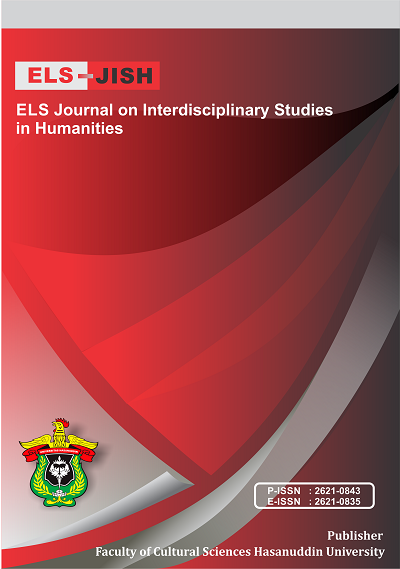Unveiling Emotional Resonance: A Musical Discourse Analysis of Taylor Swift's 'Midnights Album’ and Its Impact on “Swifties”
DOI:
https://doi.org/10.34050/els-jish.v7i4.42253Keywords:
stylistic device, thematic analysis, ;Taylor Swift’s Midnights, musical critical discourse analysis, qualitative researchAbstract
This study critically examined Taylor Swift's Midnights album's stylistic devices, thematic elements, and audience reception, employing a qualitative research design. The corpus consisted of the album's thirteen (13) songs, analyzed through the lens of Norman Fairclough's Critical Discourse Analysis (CDA) framework, encompassing description, interpretation, and explanation, and supplemented by I. R. Galperin’s theory of stylistic devices. Additionally, focus group discussions with Swifties provided insights into fan reception. The analysis identified 135 stylistic devices in the album's lyrics, including metaphor (61 instances, 45.19%), imagery (22 cases, 16.30%), simile (13 instances, 9.63%), Hyperbole (8 instances, 5.93%), personification (8 cases, 5.93%), allusion (3 instances, 2.22%), juxtaposition (1 instance, 1%), epistrophe (1 instance, 1%), and rhyme (1 instance, 1%). The recurring thematic elements in the album encompassed self-realization, self-empowerment, escape and solitude, regret and loss, vulnerability, control and manipulation, reclaiming independence, social pressure and expectation, emotional resonance, emotional detachment, emotional turmoil, acceptance, and rejecting conformity. Swifties' reception of the album revealed emergent themes, including self-reflection, self-reliance, emotional acceptance, love, vulnerability, relatability, anxiety, and pain. This study highlights the complex interplay between stylistic expression, thematic depth, and audience engagement in contemporary music discourse, offering insights into the cultural and emotional impact of Taylor Swift's Midnights.
References
Abbas, H., Arafah, B., Rahman, F., Pattu, M. A., Junus, F. G., Fachry, M. E., ... & Manaf, A. (2024). Ecological Literacy and Local Wisdom of Australian Aboriginal People in Welcome to My Country Written by Laklak Burarrwanga and Family. Theory and Practice in Language Studies, 14(5), 1493-1498.
Abrams, M. H. (1999). A Glossary of Literary Terms. Boston: Thomson Learning.
Akram, M., Farah, S., & Malik, M. (2022). The role of similes in enhancing textual meaning in song lyrics. International Journal of Literary Studies, 8(2), 45–59.
Alek, A., Yusuf, M., & Marzuki, M. (2020). Critical discourse analysis of Taylor Swift's “Look What You Made Me Do.” Journal of Media and Cultural Studies, 12(3), 76–89.
Bayram, F. (2010). Stylistic features of song lyrics: Crafting meaning through language. Journal of Applied Linguistics, 5(1), 32–50.
Beard, A. (2000). The Language of Songwriting. London: Routledge.
Boonjoon, P. (2018). Linguistic stylistics in contemporary song lyrics. Asian Journal of Language and Literature, 9(1), 15–27.
Brown, J. (2012). Vulnerability in popular music narratives. Journal of Music and Society, 14(1), 45–59.
Carlin, S. (2022). Taylor Swift’s Midnights breaks records and captivates fans. Billboard Magazine. Retrieved from billboard.com.
Creswell, J. W. (2009). Research Design: Qualitative, Quantitative, and Mixed Methods Approaches. Thousand Oaks, CA: Sage Publications.
Dancygier, B., & Sweetser, E. (2014). Figurative Language. Cambridge: Cambridge University Press.
Fairclough, N. (1992). Discourse and Social Change. Cambridge: Polity Press.
Galperin, I. R. (1981). Stylistics. Moscow: Higher School Publishing House.
Gawa, F. (2023). Freedom and autonomy in contemporary music. Bandung: Harmony Publishers.
Halliday, M. A. K. (2004). An Introduction to Functional Grammar. London: Arnold.
Halliday, M. A. K. (2007). Language and Society: A Systemic Functional Perspective. London: Continuum.
Harrison, L., & Ringrow, H. (2022). Heartbreak and nostalgia in modern pop music. Cambridge: Musicology Today.
Keraf, G. (2009). Diction and Style in Writing. Jakarta: Gramedia.
Kheraj, A. (2022). Exploring artistic evolution in Taylor Swift's lyrics. Musicology Today, 10(4), 56–72.
Knickerbocker, K. L., & Reninger, H. W. (1985). Interpreting Literature. New York: Holt, Rinehart and Winston.
Lakoff, G., & Johnson, M. (1980). Metaphors We Live By. Chicago: University of Chicago Press.
Lazar, G. (2003). Meaning and Humor in Language Teaching. Cambridge: Cambridge University Press.
Liao, J. (2020). Figurative language and personal connection in music. Journal of Linguistics and Music, 22(1), 76–88.
Mansfield, K., & Seligman, M. (2021). Music as a reflective medium: Introspection and identity in modern songwriting. Psychological Music Review, 28(4), 92–108.
Marwah, S., & Suswanto, A. (2023). Themes of self-reliance and individuality in modern music. Jakarta: Literary Perspectives Press.
Max, L., et al. (2023). Reclaiming agency through lyrical storytelling: A study of modern songwriters. International Journal of Music Studies, 15(2), 34–56.
McFarland, C., & Alvaro, E. (2000). The impact of music on self-awareness and personal reflection. Journal of Music Psychology, 12(3), 45–60.
Morris, L. (2024). Taylor Swift’s genre-bending career: An analysis. Contemporary Music Review, 13(2), 24–40.
Ősze, Z. (2023). The stylistics of Taylor Swift: Exploring cultural and personal narratives in song lyrics. Journal of Popular Music Studies, 15(1), 12–29.
Patton, M. Q. (2002). Qualitative Research & Evaluation Methods. Thousand Oaks, CA: Sage Publications.
Putra, D., Ahmad, N., & Suryanto, T. (2023). An interpersonal analysis of Taylor Swift’s “Anti-Hero.” Journal of Linguistic and Literary Research, 6(3), 98–114.
Putra, D., et al. (2023). Accountability and agency in popular music: A cultural analysis. Journal of Cultural Studies, 18(4), 89–102.
Putri, M., et al. (2022). Individuality and authenticity in music: A cultural critique. Bandung: Sonic Perspectives.
Rohmiyati, A., et al. (2023). Empowerment narratives in contemporary pop music. Yogyakarta: Pop Culture Studies.
Setiawati, A., & Maryani, S. (2018). The universality of personal narratives in music. Journal of Popular Music Studies, 10(3), 134–146.
Siallagan, R., et al. (2017). Figurative language in Taylor Swift’s 1989 album. International Journal of Language and Literature, 4(2), 55–68.
Siallagan, S., Hasibuan, R., & Dewi, K. (2017). Emotional resonance in pop music. Journal of Emotion and Music Studies, 19(2), 110–128.
Tenrisanna, R., Rahman, F., Abbas, H., & Pattu, A. (2024). Digital Story of Woman Character in Gilman’s The Yellow Wallpaper. International Journal of Religion, 5(7), 1-14.
Tulung, L., Johansyah, & Priyanto, M. (2021). Enhancing lyrical depth through similes in modern music. Studies in Literature and Language, 10(1), 89–102.
Tulung, R., et al. (2023). Strategic agency in modern pop lyrics. International Journal of Critical Discourse Studies, 9(3), 67–82.
Downloads
Published
Issue
Section
License
Copyright (c) 2024 Brandon Obenza, Steven Jay A. Silah

This work is licensed under a Creative Commons Attribution-ShareAlike 4.0 International License.






